X
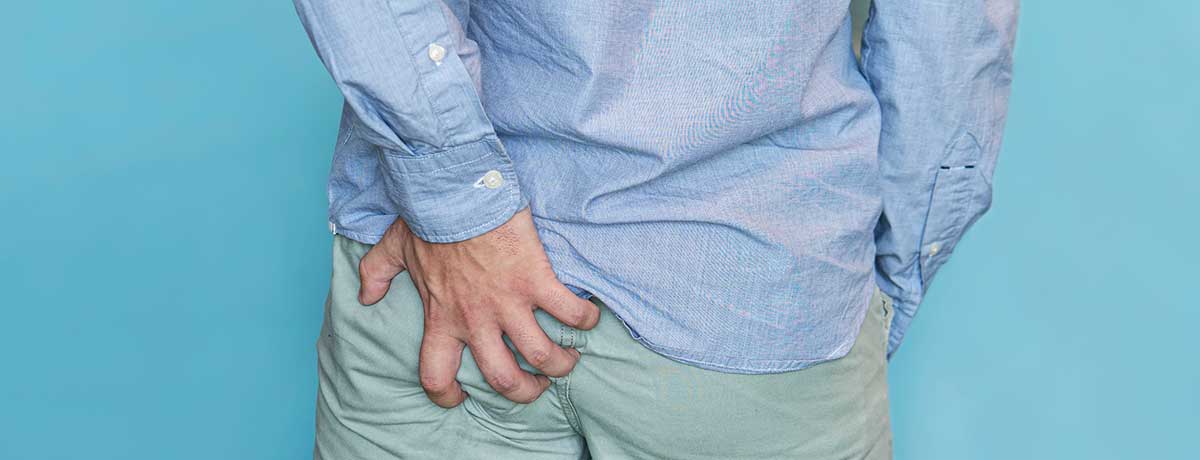


> ARTICLES
When anal itch is a symptom of an STD: Things you need to know
Written by Yeva Margaryan, MD | Published on February 11, 2024
Reviewed by Slava Fuzayloff
What is anal itch?
Anal itching or pruritus ani is a chronic, intense itching sensation affecting the anal region. Around 1-5% of people experience anal itching, which more commonly affects males aged 40-60 years old. Sometimes, the cause of anal itching cannot be found, yet in 75% of cases, there is a coexisting condition leading to this symptom. [1] Pruritus Ani. PubMed Central. https://www.ncbi.nlm.nih.gov/pmc/articles/PMC2647235/
In this article, we will discuss the most common causes of anal itching, with a particular focus on anal STDs.
What is anal sex?
Anal sex is a type of sexual activity that involves stimulation of the anus using the penis, mouth, fingers, and sex toys to achieve sexual pleasure. Anal sex is practiced by about 90% of men who have sex with men (MSM) and 5–10% of sexually active women. [2] Anal Sex Safety: What to Know. WebMD. https://www.webmd.com/sex/anal-sex-health-concerns
Chance of getting a rectal STD through receptive anal sex
The likelihood of contracting an STD through anal sex depends on various factors, such as the causative agent, the use of lubricants, and the presence of other sexually transmitted infections.But what is certain is that it is significantly higher than with other types of sexual intercourse.This is because the anal lining (the inner surface of the anus) is very delicate and can be easily damaged during anal intercourse, especially if there is insufficient lubrication. This, in turn, makes the anal area more susceptible to various infections. [3] Sexually transmitted infections of the anus and rectum. PubMed Central. https://www.ncbi.nlm.nih.gov/pmc/articles/PMC4223259/ For example, the risk of contracting HIV from receptive anal sex averages 3.4%, which is 340 times higher than the risk of contracting HIV from receptive vaginal sex (0.01%). [4] Unprotected Anal Intercourse and Sexually Transmitted Diseases in High-Risk Heterosexual Women. PubMed Central. https://www.ncbi.nlm.nih.gov/pmc/articles/PMC3052332/
STDs that cause anal itching
Chlamydia
Chlamydia is a very common sexually transmitted infection (STI), affecting more than 128.5 million adults (ages 15–49) worldwide. [5] Chlamydia. World Health Organization (WHO). https://www.who.int/news-room/fact-sheets/detail/chlamydia The infection is caused by the bacterium Chlamydia trachomatis, which often coexists with other STIs, especially gonorrhea. [6] Sexually Transmitted Diseases of the Colon, Rectum and Anus: The Challenge of the Nineties. Diseases of the Colon & Rectum. https://sci-hub.se/10.1007/BF02139224
Getting infected with anal chlamydia
A person may contract anal chlamydia through: [6] Sexually Transmitted Diseases of the Colon, Rectum and Anus: The Challenge of the Nineties. Diseases of the Colon & Rectum. https://sci-hub.se/10.1007/BF02139224
• Anal receptive sex: When his/her anus has sexual contact with the penis of a chlamydia-positive partner.
• Anilingus (rimming): When he/she receives oral-anal sex from a partner that has oral chlamydia
How common is anal chlamydia?
The prevalence of anal chlamydia is growing every year. It is estimated that anal chlamydia affects around: [7] Prevalence of and Factors Associated with Rectal-Only Chlamydia and Gonorrhoea in Women and in Men Who Have Sex with Men. PubMed Central. https://www.ncbi.nlm.nih.gov/pmc/articles/PMC4626043/
• 24.4% of men who have sex with men (MSM)
• 17.5% of women
Interestingly, among MSM,chlamydia infection is limited to the anorectal region in 53-90% of cases, while in women, anorectal-only chlamydia occurs in only 0-44% of cases.
[3, 7]
Sexually transmitted infections of the anus and rectum. PubMed Central.
https://www.ncbi.nlm.nih.gov/pmc/articles/PMC4223259/
Prevalence of and Factors Associated with Rectal-Only Chlamydia and Gonorrhoea in Women and in Men Who Have Sex with Men. PubMed Central.
https://www.ncbi.nlm.nih.gov/pmc/articles/PMC4626043/
Incubation period
In symptomatic people, the first signs and symptoms of anal chlamydia occur within 5 to 14 days of exposure. [3] Sexually transmitted infections of the anus and rectum. PubMed Central. https://www.ncbi.nlm.nih.gov/pmc/articles/PMC4223259/
Anal chlamydia symptoms
Research shows that about 85% of cases of anorectal chlamydia are asymptomatic. [3] Sexually transmitted infections of the anus and rectum. PubMed Central. https://www.ncbi.nlm.nih.gov/pmc/articles/PMC4223259/ The symptoms of anal chlamydia may include: [8] Advances in Dermatology and Allergology. Termedia. https://www.termedia.pl/Lymphogranuloma-venereum-an-emerging-problem-in-Poland,7,42602,1,1.html
• Tenesmus (a persistent sensation of needing to empty the bowels)
• Pain or itching sensation in the anus
• Enlargement of inguinal lymph nodes
• Swelling around the anus
Lymphogranuloma venereum (LGV), a chlamydia infection caused by specific to L1, L2, and L3 serotypes, has more severe manifestation and can result in:
[3, 6, 8]
Sexually transmitted infections of the anus and rectum. PubMed Central.
https://www.ncbi.nlm.nih.gov/pmc/articles/PMC4223259/
Sexually Transmitted Diseases of the Colon, Rectum and Anus: The Challenge of the Nineties. Diseases of the Colon & Rectum.
https://sci-hub.se/10.1007/BF02139224
Advances in Dermatology and Allergology. Termedia.
https://www.termedia.pl/Lymphogranuloma-venereum-an-emerging-problem-in-Poland,7,42602,1,1.html
• Anal or perianal ulcers
• Lower abdominal pain or cramping
• Anal fissures
• Perianal abscesses
• Diarrhea
• Rectovaginal fistula(s) (an abnormal opening between the rectum and vagina that allows stool to pass from the rectum into the vagina)
• Enlargement of inguinal lymph nodes
Often, symptoms resolve on their own within 7 days. [8] Advances in Dermatology and Allergology. Termedia. https://www.termedia.pl/Lymphogranuloma-venereum-an-emerging-problem-in-Poland,7,42602,1,1.html
Complication
Anal chlamydia can lead to:
[6, 9, 10]
Sexually Transmitted Diseases of the Colon, Rectum and Anus: The Challenge of the Nineties. Diseases of the Colon & Rectum.
https://sci-hub.se/10.1007/BF02139224
High co-occurrence of anorectal chlamydia with urogenital chlamydia in women visiting an STI clinic revealed by routine universal testing in an observational study; a recommendation towards a better anorectal chlamydia control in women. PubMed Central.
https://www.ncbi.nlm.nih.gov/pmc/articles/PMC4032161/
Does Chlamydia Increase Anal Cancer Risk in People With HIV? POZ.
https://www.poz.com/article/chlamydia-increase-anal-cancer-risk-people-hiv#:~:text=Having%20both%20chlamydia%20and%20high,the%20risk%20of%20anal%20precancer.
• Rectal strictures (narrowing of the anal canal)
• Anal cancer (in fact, people who are also infected with HPV type 16 are approximately 31 times more likely to develop anal cancer)
• Increased risk of HIV infection.
Anal chlamydia pictures
Chlamydia-resulted ulceration in the anal area
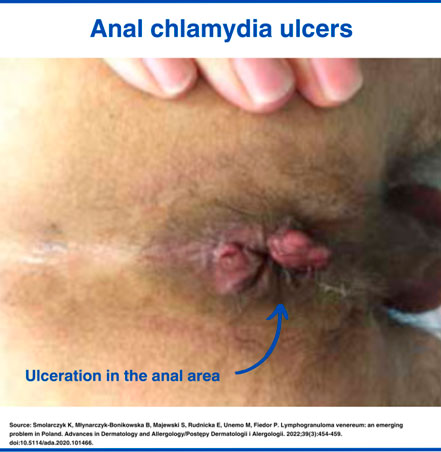
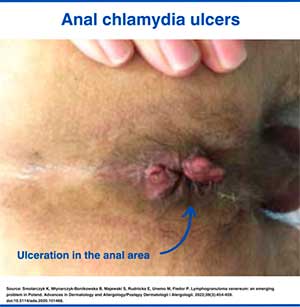
Gonorrhea
Gonorrhea, or the clap, is another widespread STD affecting over 82 million people globally. In 2021, over 28,000 gonorrhea cases have been reported in New York City, with around 21,000 cases among males and 7000 among females, respectively. The infection is caused by the bacterium Neisseria gonorrhoeae (gonococcus), which affects genital and anal regions as well as throat and eyes.
[11, 12]
Gonorrhoea (Neisseria gonorrhoeae infection). World Health Organization (WHO).
https://www.who.int/news-room/fact-sheets/detail/gonorrhoea-(neisseria-gonorrhoeae-infection)
Sexually Transmitted Infections Surveillance Report, 2021. NYC.gov.
https://www.nyc.gov/assets/doh/downloads/pdf/std/sti-2021-report.pdf
Getting infected with anal gonorrhea
The causative bacterium of gonorrhea is found in genital fluids, so, one can easily contract anal gonorrhea if his/her anal area is exposed to vaginal or penile discharge. This can happen through:
[6, 13]
Sexually Transmitted Diseases of the Colon, Rectum and Anus: The Challenge of the Nineties. Diseases of the Colon & Rectum.
https://sci-hub.se/10.1007/BF02139224
Herpes simplex virus. World Health Organization (WHO).
https://www.who.int/en/news-room/fact-sheets/detail/herpes-simplex-virus
• Receptive anal sex, when their anus comes into contact with the penis of a gonorrhea-positive partner.
• Using sex toys or vibrators to stimulate the anal region without proper cleaning and without using a condom.
• Autoinoculation (self-transmission of infection from one part of the body to another) of a vaginal infection into the anus
How common is anal gonorrhea?
According to research, anal gonorrhea affects around: [7] Prevalence of and Factors Associated with Rectal-Only Chlamydia and Gonorrhoea in Women and in Men Who Have Sex with Men. PubMed Central. https://www.ncbi.nlm.nih.gov/pmc/articles/PMC4626043/
• 17.9% of men who have sex with men (MSM)
• 13.4% of women
Cases where anal gonorrhea is the only site of infection occur in approximately 50% of MSM. However, only 6% of women with anal gonorrhea do not have a concurrent gonococcal infection of the cervix or urethra. [6] Sexually Transmitted Diseases of the Colon, Rectum and Anus: The Challenge of the Nineties. Diseases of the Colon & Rectum. https://sci-hub.se/10.1007/BF02139224
Incubation period
The incubation period (time between exposure and the appearance of the first symptoms)of anal gonorrhea averages 5-10 days. [3] Sexually transmitted infections of the anus and rectum. PubMed Central. https://www.ncbi.nlm.nih.gov/pmc/articles/PMC4223259/
Anal gonorrhea symptoms
Around 84% of anal gonorrhea cases are asymptomatic.
[3]
Sexually transmitted infections of the anus and rectum. PubMed Central.
https://www.ncbi.nlm.nih.gov/pmc/articles/PMC4223259/
Symptomatic patients may experience:
[3, 6]
Sexually transmitted infections of the anus and rectum. PubMed Central.
https://www.ncbi.nlm.nih.gov/pmc/articles/PMC4223259/
Sexually Transmitted Diseases of the Colon, Rectum and Anus: The Challenge of the Nineties. Diseases of the Colon & Rectum.
https://sci-hub.se/10.1007/BF02139224
• Anal itching
• Constipation
• Discharge (containing mucous and pus)
• Anal bleeding
• Pain
• Tenesmus (a persistent sensation of needing to empty the bowels)
• Redness of anal mucosa
Complications
In advanced stages, gonorrhea can be spread through the body and cause systemic disease resulting in: [6] Sexually Transmitted Diseases of the Colon, Rectum and Anus: The Challenge of the Nineties. Diseases of the Colon & Rectum. https://sci-hub.se/10.1007/BF02139224
• Meningitis: inflammation of the membranes covering the brain and spinal cord
• Endocarditis: inflammation of the inner lining of the heart and its valves
• Pericarditis: Inflammation of the membrane covering the heart
• Arthritis (inflammation of the joints)
Herpes
Herpes is a viral infection caused by Herpes simplex virus type-1 (HSV-1) or Herpes simplex virus type-2 (HSV-2). The former most commonly affects the oral region causing painful cold sores, while the latter is responsible for most genital and anal infections. According to the WHO estimates, about 3.7 billion people are affected by HSV-1 globally, which equals approximately 67% of the global population. For HSV-2, it affects approximately 491 million people globally, which accounts for around 13% of the global population. [13] Herpes simplex virus. World Health Organization (WHO). https://www.who.int/en/news-room/fact-sheets/detail/herpes-simplex-virus
Getting infected with anal herpes
About 90% of anal herpes cases are caused by HSV-2 infection, which is primarily transmitted through direct skin-to-skin (or mucosa-to-mucosa) contact during receptive anal sex when the anus of an uninfected person comes into contact with the penis of a herpes-positive partner [6] Sexually Transmitted Diseases of the Colon, Rectum and Anus: The Challenge of the Nineties. Diseases of the Colon & Rectum. https://sci-hub.se/10.1007/BF02139224
Rarely, anal herpes is contracted through: [14] Anal infections caused by Herpes Simplex Virus. Diseases of the Colon & Rectum. https://sci-hub.se/10.1007/BF02590871
• Autoinfection from the genital area
• Oral-anal contact (when someone with herpes blisters on his/her lips performs rimming (anilingus) on an uninfected individual). In this case, a person would most likely contract HSV type 1
How common is anal herpes?
Herpes infection is found in approximately 6–30% of MSM experiencing anal symptoms. However, in about 30% of these cases (one-third of cases), these symptoms are caused by another infection. [6] Sexually Transmitted Diseases of the Colon, Rectum and Anus: The Challenge of the Nineties. Diseases of the Colon & Rectum. https://sci-hub.se/10.1007/BF02139224
Incubation period
The incubation period for anal herpes ranges from 4 to 21 days. [6] Sexually Transmitted Diseases of the Colon, Rectum and Anus: The Challenge of the Nineties. Diseases of the Colon & Rectum. https://sci-hub.se/10.1007/BF02139224
Anal herpes symptoms
The symptoms of anal herpes include:
[3, 6]
Sexually transmitted infections of the anus and rectum. PubMed Central.
https://www.ncbi.nlm.nih.gov/pmc/articles/PMC4223259/
Sexually Transmitted Diseases of the Colon, Rectum and Anus: The Challenge of the Nineties. Diseases of the Colon & Rectum.
https://sci-hub.se/10.1007/BF02139224
• Lesions: Small fluid-filled vesicles (rarely large solitary lesions) that ulcerate and resolve on their own within a few days. They are usually located around the anus or inside the anal canal, less often on the rectum.
• Pain: About 95% of people with anal herpes experience pain or burning in the anal area, which gets worse during anal sex and bowel movements. The pain can be severe and usually lasts until the blisters go away. Sometimes, the pain radiates to the upper thighs, lower abdomen, groin, and buttocks.
• Itching: The herpes virus affects sensory nerves, causing persistent anal itching, which is experienced by approximately 50–85% of patients.
• Discharge: A clear, watery discharge that may become purulent (thick, yellowish discharge containing pus) if the lesions become infected with other infection
• Tenesmus: A persistent sensation of needing to empty the bowels
• Fever and chills: Mostly experienced by those who have the first outbreak
• Enlargement of inguinal lymph nodes: Usuallyon both sides
• Bloody bowel movements
• Impotence
It's important to note that the first outbreak of anal herpes is known to be the most severe, and symptoms become milder with each outbreak.
Complications
In most cases, anal herpes goes away on its own within three weeks, leaving no scars or complications. However, sometimes a herpes infection can lead to: [15] Herpes: HSV-1 and HSV-2. Johns Hopkins Medicine. https://www.hopkinsmedicine.org/health/conditions-and-diseases/herpes-hsv1-and-hsv2
• Meningitis: inflammation of the membranes that covers the brain and spinal cord
• Encephalitis: Inflammation of the brain
Anal herpes pictures
Anal herpes outbreak
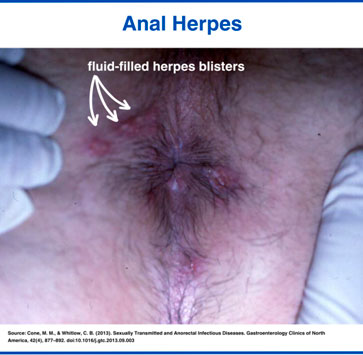
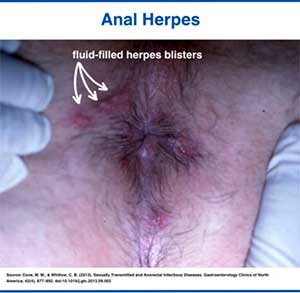
HPV
HPV (human papillomavirus) is the most commonly diagnosed STI in the world. In 2018, there were approximately 43 million cases of HPV reported worldwide. There are about forty genotypes of the virus that cause anal and genital lesions, which can be benign warts (caused mainly by HPV types 6 and 11) and cancerous lesions (caused mainly by HPV types 16 and 18).
[16, 17]
Anal human papillomavirus infection: prevalence, diagnosis and treatment of related lesions. Expert Review of Anti-infective Therapy.
https://sci-hub.se/10.1586/14787210.2016.1174065
Genital HPV Infection – Basic Fact Sheet. Centers for Disease Control and Prevention (CDC).
https://www.cdc.gov/std/hpv/stdfact-hpv.htm
Getting infected with anal HPV
People become infected with anal HPV through skin-to-skin contact during anal or oral sex. More precisely, a person can become infected with anal HPV if his/her anal skin or mucosa comes into contact with the skin or mucosa of the mouth or genitals of an infected partner. [16] Anal human papillomavirus infection: prevalence, diagnosis and treatment of related lesions. Expert Review of Anti-infective Therapy. https://sci-hub.se/10.1586/14787210.2016.1174065
Condoms may lower the risk of HPV transmission during receptive anal sex. However, the infection can still be spread through the parts of the skin beyond the area protected by a condom. [16] Anal human papillomavirus infection: prevalence, diagnosis and treatment of related lesions. Expert Review of Anti-infective Therapy. https://sci-hub.se/10.1586/14787210.2016.1174065
Chance of contracting anal HPV
HPV infection is highly contagious. However, the risk of transmitting HPV from penile skin to the anal skin during anal intercourse is much higher than vice versa. Thus, the probability of infection with anal HPV during receptive anal intercourse is 50% (per partner), while during insertive anal sex, this probability is only 0.8-14.2%. [16] Anal human papillomavirus infection: prevalence, diagnosis and treatment of related lesions. Expert Review of Anti-infective Therapy. https://sci-hub.se/10.1586/14787210.2016.1174065
How common is anal HPV?
The prevalence of HPV among different population groups is as follows: [16] Anal human papillomavirus infection: prevalence, diagnosis and treatment of related lesions. Expert Review of Anti-infective Therapy. https://sci-hub.se/10.1586/14787210.2016.1174065
• Over 90% of HIV-positive MSM have at least one type of HPV infection. Moreover, around 60% of these people are infected with cancer-causing, high-risk HPV serotypes. that cause cancer. For HIV-negative MSM, this number ranges from 30-50%.
• About 32% of women are positive for anal HPV
• About 14% of heterosexual men (men who have sex with women) are infected with HPV. This number is up to 3 times higher for those with HIV-positive status.
Anal HPV symptoms
Most cases of anal HPV are asymptomatic. If symptoms do occur, they may include: [3] Sexually transmitted infections of the anus and rectum. PubMed Central. https://www.ncbi.nlm.nih.gov/pmc/articles/PMC4223259/
• Flesh-colored or pinky, cauliflower-like lesions
• Anal itching
• Pain and discomfort
• Anal discharge and/or bleeding
Complications
In 90% of cases, anal HPV goes away on its own within two years. However, if a person is infected with a high-risk type of HPV and it is not cleared within the mentioned period of time, it can lead to the development of anal cancer. In fact, HPV is the leading cause of anal cancer, as about 80% of anal cancers are attributed to this infection.
[16, 17]
Anal human papillomavirus infection: prevalence, diagnosis and treatment of related lesions. Expert Review of Anti-infective Therapy.
https://sci-hub.se/10.1586/14787210.2016.1174065
Genital HPV Infection – Basic Fact Sheet. Centers for Disease Control and Prevention (CDC).
https://www.cdc.gov/std/hpv/stdfact-hpv.htm
Anal HPV pictures
Multiple HPV warts in anal region
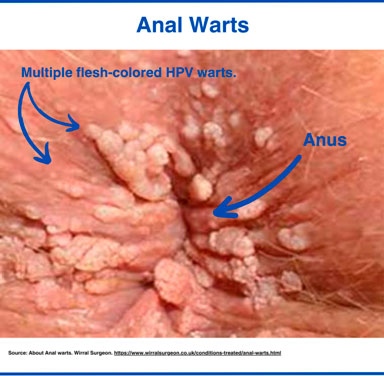
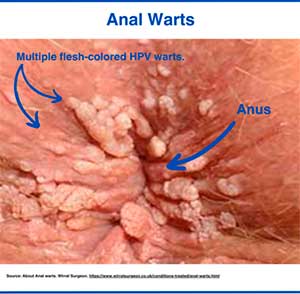
Syphilis
Syphilis is a bacterial sexually transmitted infection (STI) caused by Treponema pallidum. The disease progresses through four stages and can potentially lead to serious complications and even death without proper treatment. There were 9,965 cases of syphilis reported in New York City in 2021.
[12]
Sexually Transmitted Infections Surveillance Report, 2021. NYC.gov.
https://www.nyc.gov/assets/doh/downloads/pdf/std/sti-2021-report.pdf
Getting infected with anal syphilis
People get anal syphilis through anal sex and anilingus (rimming) when the skin or mucous membrane of their anus comes into contact with a syphilitic lesion(s) located on the partner's:
[18]
Syphilis. PubMed Central.
https://www.ncbi.nlm.nih.gov/pmc/articles/PMC1779891/
• Penis (during anal sex)
• Month or tongue (during rimming)
Chance of contracting anal syphilis
The estimated per-act probability of getting anal syphilis through penile-anal intercourse is around 1.4%.
[19]
Syphilis transmission: a review of the current evidence. PubMed Central.
https://www.ncbi.nlm.nih.gov/pmc/articles/PMC5973824/
Syphilis is highly contagious in its early stages: about 30-60% of sexual partners of a person with primary and secondary syphilis eventually become infected.
[18]
Syphilis. PubMed Central.
https://www.ncbi.nlm.nih.gov/pmc/articles/PMC1779891/
How common is anal syphilis?
According to a study conducted in Sydney, Australia, approximately 5.4% of gay and bisexual men have anal syphilis.
[20]
Prevalence, incidence and predictors of anal Chlamydia trachomatis, anal Neisseria gonorrhoeae and syphilis among older gay and bisexual men in the longitudinal Study for the Prevention of AnalCancer (SPANC). Sexually Transmitted Infections.
https://sci-hub.se/10.1136/sextrans-2019-054011
There is no data on the prevalence of anal syphilis among women.
Incubation period
The symptoms of anal syphilis usually occur within 2 to 6 weeks after contracting the infection. However, the incubation period (time between exposure and first symptoms) can sometimes last up to 3 months. [6] Sexually Transmitted Diseases of the Colon, Rectum and Anus: The Challenge of the Nineties. Diseases of the Colon & Rectum. https://sci-hub.se/10.1007/BF02139224
Anal syphilis symptoms
About 50% of patients infected with syphilis have no symptoms at all.
[21]
Syphilis as an atypical cause of perianal fissure.PubMed Central.
https://www.ncbi.nlm.nih.gov/pmc/articles/PMC6255878/
The manifestation of anal syphilis depends on the stage of the disease. Although primary symptoms of syphilis affecting the anal area indicate anal transmission of the disease, anal lesions in secondary and tertiary syphilis are not necessarily due to anal syphilis (when the infection is acquired through sexual contact involving the anus).Those can occur anywhere in the body, regardless of the initial exposure site. Below are the stage-specific syphilis symptoms affecting the anal region.
[3]
Sexually transmitted infections of the anus and rectum. PubMed Central.
https://www.ncbi.nlm.nih.gov/pmc/articles/PMC4223259/
Anal symptoms of primary syphilis:
• Primary syphilitic lesion (chancre): A single or multiple painful ulcer(s) in the perianal area, anal margin, or canal. They are irregularly shaped and can be positioned opposite each other in a "kissing" or "mirror" configuration.Ulcers can be mistaken for anal fissures; however, anal syphilis often causes enlarged inguinal lymph nodes, which can help differentiate the two conditions.
• Proctitis (inflammation of the rectum) that may cause itching, pain, or discomfort in the anal region as well as rectal bleeding and discharge
Anal symptoms of secondary syphilis (resolve within 3-12 weeks):
[6, 21]
Sexually Transmitted Diseases of the Colon, Rectum and Anus: The Challenge of the Nineties. Diseases of the Colon & Rectum.
https://sci-hub.se/10.1007/BF02139224
Syphilis as an atypical cause of perianal fissure.PubMed Central.
https://www.ncbi.nlm.nih.gov/pmc/articles/PMC6255878/
• Condyloma lata: A large mass around the anus consisting of multiple raised cauliflower-like warts that are pale brown or pinkish in color. These lesions secret mucus, which causes anal itching and a foul odor.
•
Mucous patches:
Painless, oval, flat lesions with slightly raised edges and a whitish-grayish covering
[22]
MUCOSAL PATCH ON ANUS: A RARE SEQUEL OF SODOMY.PubMed Central.
https://www.ncbi.nlm.nih.gov/pmc/articles/PMC2763769/
Anal symptoms of tertiary syphilis:
• Anal gummas: Soft tumor-like growths or nodules that can cause local tissue destruction, ulceration, and scarring. [3] Sexually transmitted infections of the anus and rectum. PubMed Central. https://www.ncbi.nlm.nih.gov/pmc/articles/PMC4223259/
Complications
Anal syphilis can cause local complications such as:
[21]
Syphilis as an atypical cause of perianal fissure.PubMed Central.
https://www.ncbi.nlm.nih.gov/pmc/articles/PMC6255878/
• Perianal fissure
• Ulcerative gummas
• Anal stenosis (narrowing of the anal canal)
In advanced stages, the infection can also affect other parts of the body, leading to serious consequences, including:
[18]
Syphilis. PubMed Central.
https://www.ncbi.nlm.nih.gov/pmc/articles/PMC1779891/
• Cardiovascular diseases
• Damage to the brain and spinal cord.
• Blurred vision and blindness.
• Death
Anal syphilis pictures
Perianal syphilitic lesion (chancre)
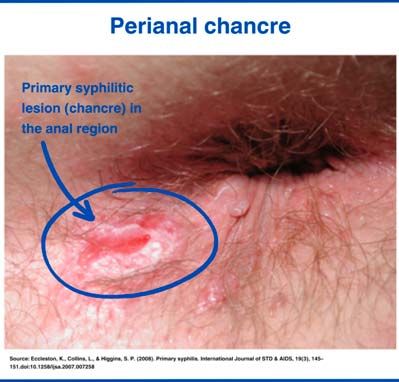
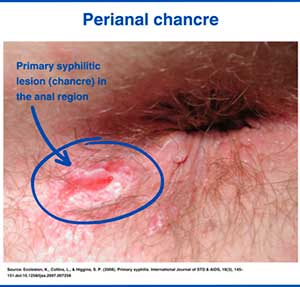
Secondary syphilis:Perianal condylomatalata
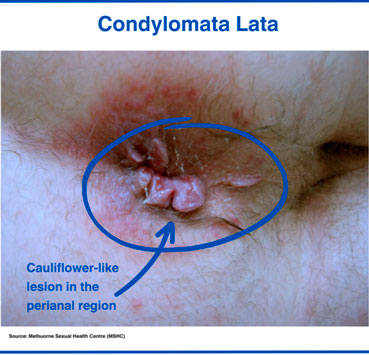
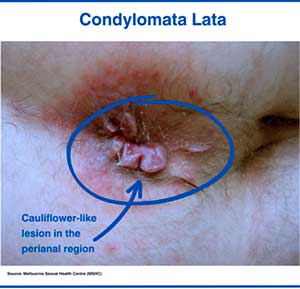
Secondary syphilis: Analmucosal patch
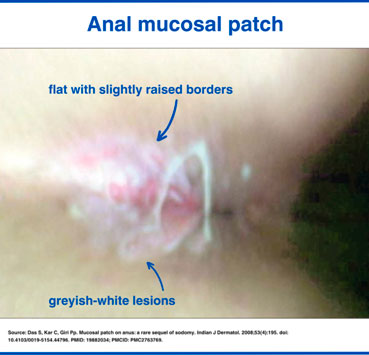
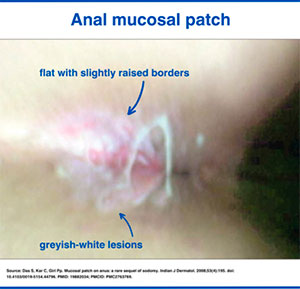
Other common causes of anal itching
There are about 100 causes of anal itching other than STDs. Below, we will discuss the most common ones.
[1]
Pruritus Ani. PubMed Central.
https://www.ncbi.nlm.nih.gov/pmc/articles/PMC2647235/
Anal diseases
Anal diseases are found in up to 52% of individuals with anal itching. Of these, anal fissures and hemorrhoids are most often noted.
[1]
Pruritus Ani. PubMed Central.
https://www.ncbi.nlm.nih.gov/pmc/articles/PMC2647235/
Hemorrhoids
Hemorrhoids are responsible for 20% of anal itching cases.
[23]
Pruritus Ani: Causes and Concerns. Diseases of the Colon & Rectum.
https://sci-hub.se/10.1007/BF02054410
The disease affects up to 55% of the population and is characterized by inflammation of the veins of the anus, causing anal bleeding (bright red), pain, swelling, itching, and mucus discharge.
[24]
Japanese Practice Guidelines for Anal Disorders I. Hemorrhoids.PubMed Central.
https://www.ncbi.nlm.nih.gov/pmc/articles/PMC6768674/
Anal Fissure
Around 12% of anal itching cases are caused by anal fissures.These are tiny cuts or tears in the anus that cause bleeding, discomfort, and pain, especially during defecation.
[23]
Pruritus Ani: Causes and Concerns. Diseases of the Colon & Rectum.
https://sci-hub.se/10.1007/BF02054410
Crabs
Crabs or pubic lice are tiny insects that live in the hair of the genital area. They are transmitted through close contact, including sexual contact. Anal itching caused by these parasites usually begins within 3 weeks of infection and gets worse at night.
[25]
Pubic Lice. NHS Inform.
https://www.nhsinform.scot/illnesses-and-conditions/sexual-and-reproductive/pubic-lice/#:~:text=The%20most%20common%20symptom%20of,usually%20be%20worse%20at%20night.
Skin conditions
Various skin conditions may cause anal itching. The most common ones are:
[1, 26]
Pruritus Ani. PubMed Central.
https://www.ncbi.nlm.nih.gov/pmc/articles/PMC2647235/
Pruritus Ani. PubMed Central.
https://www.ncbi.nlm.nih.gov/pmc/articles/PMC4755774/
• Psoriasis. About 5-55% of people with anal itching have psoriasis. This is a chronic inflammatory skin disease characterized by the appearance of painful and/ or itchy red spots covered with whitish scales. In the anal area, skin rashes often have a “butterfly” shape.
• Atopic dermatitis (eczema). It is a skin condition caused by allergic reactions to various compounds that affect the anal skin, such as creams, gels, cosmetics, and laundry detergents. It is characterized by the appearance of dry, reddish lesions and itching and/or irritation of the affected skin.
• Yeast infection (candidiasis). This disease usually affects people with suppressed immune systems, those who wear tight clothing and underwear, and those who take antibiotics. It occurs in moist, sweaty areas of the skin and appears as red patches, sometimes accompanied by small rashes around them.
Parasites
Anal itching can also be resulted from some parasitic infections. The most common ones are:
•
Pinworms.
About 30% of patients with pinworms are asymptomatic Among symptomatic people, the most common symptom is persistent anal itching. Patients may also experience redness of the skin (mostly associated with scratching the itchy skin), watery diarrhea, and abdominal pain.
[27]
Enterobius Vermicularis. PubMed Central.
https://www.ncbi.nlm.nih.gov/books/NBK536974/
•
Tapeworms
are parasites that live in the intestines of humans and animals. Along with anal itching, patients may experience diarrhea, weakness, loss of appetite, and abdominal pain or discomfort.
[28]
Tapeworm infection –hymenolepsis. University of Florida.
https://ufhealth.org/conditions-and-treatments/tapeworm-infection-hymenolepsis
Personal habits
Analitching can also result from different habits and lifestyle changes, such as:
[26]
Pruritus Ani. PubMed Central.
https://www.ncbi.nlm.nih.gov/pmc/articles/PMC4755774/
• Excessive cleaning of the anus. Some soaps and shower gels can cause itchy skin, including the skin of the anus. Vigorous scrubbing and excessive cleaning of the anal area after defecation can irritate the skin or aggravate existing microtrauma and irritation. Unfortunately, people tend to respond to irritation and itching by more excessive cleansing, which creates a vicious cycle.
• Residual stool after defecation. This is the opposite of over-cleaning. The presence of residual stool can lead to the irritation and itching of anal skin. This problem is particularly prevalent among patients experiencing diarrhea.
• Tight clothes and underwear. Clothing itself does not cause anal itching, but the sweat that can result from wearing tight clothes does.
• Food. Certain foods and drinks, such as dairy products, peanuts, tomatoes, citrus fruits, spicy foods, alcohol, caffeinated drinks, and chocolate, can cause anal itching.
Medications
Some oral tablets may cause anal itching by directly irritating the anal skin or indirectly by causing diarrhea. The list of these medications includes:
[26]
Pruritus Ani. PubMed Central.
https://www.ncbi.nlm.nih.gov/pmc/articles/PMC4755774/
• Laxatives
• Colpermin
• Colchicine
• Quinidine
• Peppermint oil
• Some antibiotics
Other health conditions
Rarely, anal itching can be caused by the following health conditions:
[1]
Pruritus Ani. PubMed Central.
https://www.ncbi.nlm.nih.gov/pmc/articles/PMC2647235/
• Type 2 diabetes
• Leukemia and lymphoma
• Hyperthyroidism
• Kidney failure
• Liver disease
• Anemia
• Stress
Diagnosis
To diagnose the condition, the provider may perform a physical examination, take the patient's medical history, and ask questions about recent exposure to anal STIs. If the latter is the cause of anal itching, a blood test or swab test of the anus and genitals may be required.
[29]
Is an Itchy Anus the Sign of an STI?Verywell Health.
https://www.verywellhealth.com/itchy-anus-std-5443108
Treatment
The treatment depends on the cause of the itching.
[29]
Is an Itchy Anus the Sign of an STI?Verywell Health.
https://www.verywellhealth.com/itchy-anus-std-5443108
• Chlamydia, gonorrhea, and syphilis are treated with specific antibiotics.
• Anal warts can be removed by cryotherapy, laser therapy, or surgery
• There is no cure for herpes, but antiviral medications can significantly reduce the severity and duration of an outbreak.
Recommendations for the treatment of other conditions are as follows:
[1, 29]
Pruritus Ani. PubMed Central.
https://www.ncbi.nlm.nih.gov/pmc/articles/PMC2647235/
Is an Itchy Anus the Sign of an STI?Verywell Health.
https://www.verywellhealth.com/itchy-anus-std-5443108
• People with skin conditions are advised to visit a dermatologist for evaluation and treatment recommendations.
• Hemorrhoids and anal fissures should also be examined by a specialist (proctologist), and depending on the severity of the condition, a topical cream, diet change, or surgery may be indicated.
• Crabs can be treated with specific prescription or over-the-counter lotions.
•
If personal habits are the cause of anal itching, the person may be advised to take some self-care measures or make dietary changes (limiting foods and drinks that cause anal itching may resolve the problem within 14 days).
[26]
Pruritus Ani. PubMed Central.
https://www.ncbi.nlm.nih.gov/pmc/articles/PMC4755774/
Prevention
Anal itching caused by an STD can be prevented by:
[30]
How You Can Prevent Sexually TransmittedDiseases. Centers for Disease Control and Prevention (CDC).
https://www.cdc.gov/std/prevention/default.htm#:~:text=Use%20a%20condom%20every%20time,not%20recommended%20for%20STD%20prevention.
• Using condoms during anal sex. It is important to use a new condom if anal sex follows vaginal sex.
• Limiting the number of sexual partners. It is best to be in a mutually monogamous relationship.
• HPV vaccination. The infection can be transmitted even through protected sexual contact, so vaccination is the only way to be fully protected.
• Use of lubricants during anal sex to prevent microtraumas, which make the anal mucosa more vulnerable to various infections.
Summary
Anal itching is a nonspecific symptom that can be caused by various infectious and non-infectious conditions. STDs are one of the common causes of anal itching, especially among those practicing anal sexual intercourse. Importantly, timely diagnosis and management of anal STDs can prevent further transmission and serious complications.
Source
-
Pruritus Ani. PubMed Central.
https://www.ncbi.nlm.nih.gov/pmc/articles/PMC2647235/ -
Anal Sex Safety: What to Know. WebMD.
https://www.webmd.com/sex/anal-sex-health-concerns -
Sexually transmitted infections of the anus and rectum. PubMed Central.
https://www.ncbi.nlm.nih.gov/pmc/articles/PMC4223259/ -
Unprotected Anal Intercourse and Sexually Transmitted Diseases in High-Risk Heterosexual Women. PubMed Central.
https://www.ncbi.nlm.nih.gov/pmc/articles/PMC3052332/ -
Chlamydia. World Health Organization (WHO).
https://www.who.int/news-room/fact-sheets/detail/chlamydia -
Sexually Transmitted Diseases of the Colon, Rectum and Anus: The Challenge of the Nineties. Diseases of the Colon & Rectum.
https://sci-hub.se/10.1007/BF02139224 -
Prevalence of and Factors Associated with Rectal-Only Chlamydia and Gonorrhoea in Women and in Men Who Have Sex with Men. PubMed Central.
https://www.ncbi.nlm.nih.gov/pmc/articles/PMC4626043/ -
Advances in Dermatology and Allergology. Termedia.
https://www.termedia.pl/Lymphogranuloma-venereum-an-emerging-problem-in-Poland,7,42602,1,1.html -
High co-occurrence of anorectal chlamydia with urogenital chlamydia in women visiting an STI clinic revealed by routine universal testing in an observational study; a recommendation towards a better anorectal chlamydia control in women. PubMed Central.
https://www.ncbi.nlm.nih.gov/pmc/articles/PMC4032161/
-
Does Chlamydia Increase Anal Cancer Risk in People With HIV? POZ.
https://www.poz.com/article/chlamydia-increase-anal-cancer-risk-people-hiv#:~:text=Having%20both%20chlamydia%20and%20high,the%20risk%20of%20anal%20precancer. -
Gonorrhoea (Neisseria gonorrhoeae infection). World Health Organization (WHO).
https://www.who.int/news-room/fact-sheets/detail/gonorrhoea-(neisseria-gonorrhoeae-infection) -
Sexually Transmitted Infections Surveillance Report, 2021. NYC.gov.
https://www.nyc.gov/assets/doh/downloads/pdf/std/sti-2021-report.pdf -
Herpes simplex virus. World Health Organization (WHO).
https://www.who.int/en/news-room/fact-sheets/detail/herpes-simplex-virus -
Anal infections caused by Herpes Simplex Virus. Diseases of the Colon & Rectum.
https://sci-hub.se/10.1007/BF02590871 -
Herpes: HSV-1 and HSV-2. Johns Hopkins Medicine.
https://www.hopkinsmedicine.org/health/conditions-and-diseases/herpes-hsv1-and-hsv2 -
Anal human papillomavirus infection: prevalence, diagnosis and treatment of related lesions. Expert Review of Anti-infective Therapy.
https://sci-hub.se/10.1586/14787210.2016.1174065 -
Genital HPV Infection – Basic Fact Sheet. Centers for Disease Control and Prevention (CDC).
https://www.cdc.gov/std/hpv/stdfact-hpv.htm -
Syphilis. PubMed Central.
https://www.ncbi.nlm.nih.gov/pmc/articles/PMC1779891/ -
Syphilis transmission: a review of the current evidence. PubMed Central.
https://www.ncbi.nlm.nih.gov/pmc/articles/PMC5973824/
-
Prevalence, incidence and predictors of anal Chlamydia trachomatis, anal Neisseria gonorrhoeae and syphilis among older gay and bisexual men in the longitudinal Study for the Prevention of AnalCancer (SPANC). Sexually Transmitted Infections.
https://sci-hub.se/10.1136/sextrans-2019-054011 -
Syphilis as an atypical cause of perianal fissure.PubMed Central.
https://www.ncbi.nlm.nih.gov/pmc/articles/PMC6255878/ -
MUCOSAL PATCH ON ANUS: A RARE SEQUEL OF SODOMY.PubMed Central.
https://www.ncbi.nlm.nih.gov/pmc/articles/PMC2763769/ -
Pruritus Ani: Causes and Concerns. Diseases of the Colon & Rectum.
https://sci-hub.se/10.1007/BF02054410 -
Japanese Practice Guidelines for Anal Disorders I. Hemorrhoids.PubMed Central.
https://www.ncbi.nlm.nih.gov/pmc/articles/PMC6768674/ -
Pubic Lice. NHS Inform.
https://www.nhsinform.scot/illnesses-and-conditions/sexual-and-reproductive/pubic-lice/#:~:text=The%20most%20common%20symptom%20of,usually%20be%20worse%20at%20night. -
Pruritus Ani. PubMed Central.
https://www.ncbi.nlm.nih.gov/pmc/articles/PMC4755774/ -
Enterobius Vermicularis. PubMed Central.
https://www.ncbi.nlm.nih.gov/books/NBK536974/ -
Tapeworm infection –hymenolepsis. University of Florida.
https://ufhealth.org/conditions-and-treatments/tapeworm-infection-hymenolepsis -
Is an Itchy Anus the Sign of an STI?Verywell Health.
https://www.verywellhealth.com/itchy-anus-std-5443108 -
How You Can Prevent Sexually TransmittedDiseases. Centers for Disease Control and Prevention (CDC).
https://www.cdc.gov/std/prevention/default.htm#:~:text=Use%20a%20condom%20every%20time,not%20recommended%20for%20STD%20prevention.

By Yeva Margaryan, MD
Dr. Yeva Margaryan is a public health specialist specialized in population health promotion and research.

